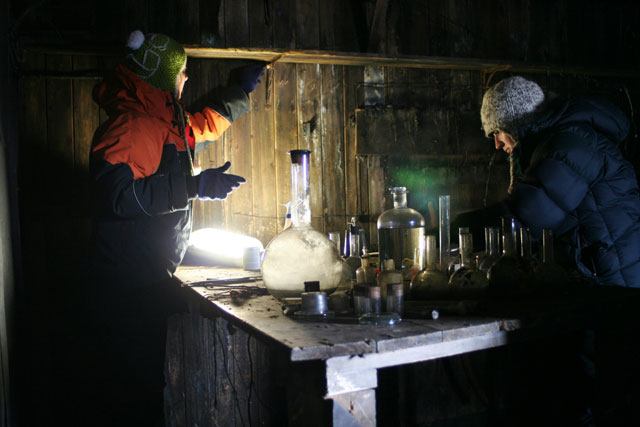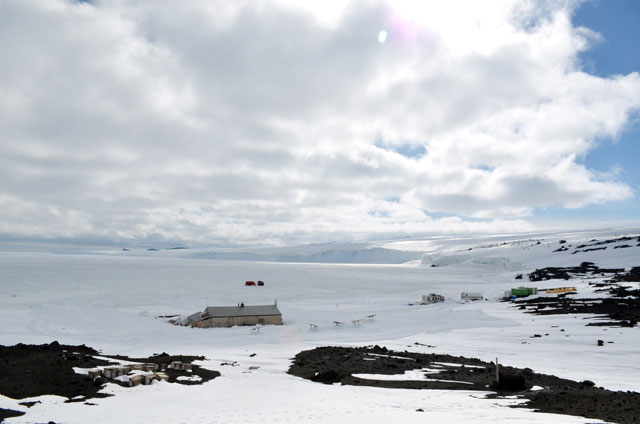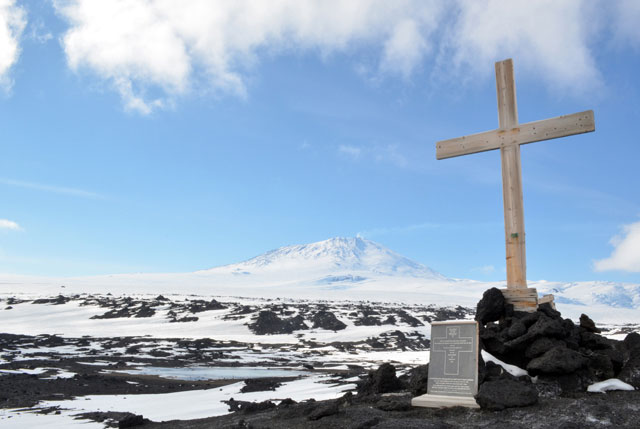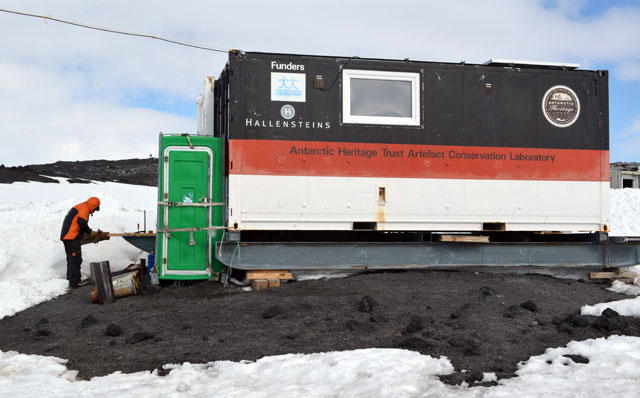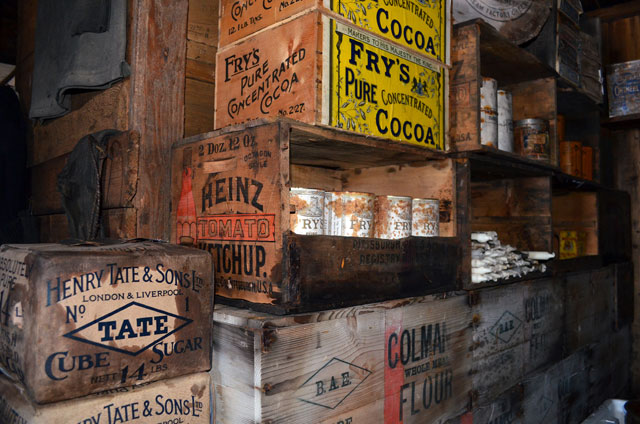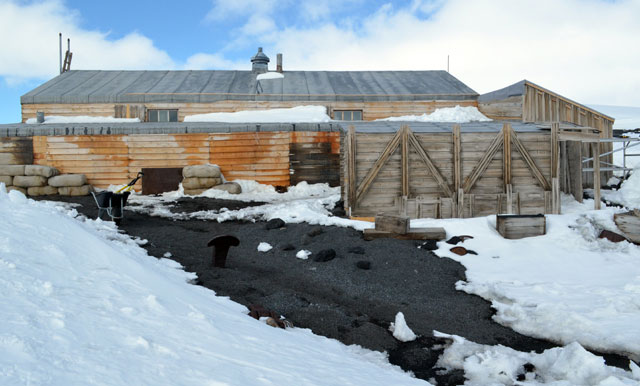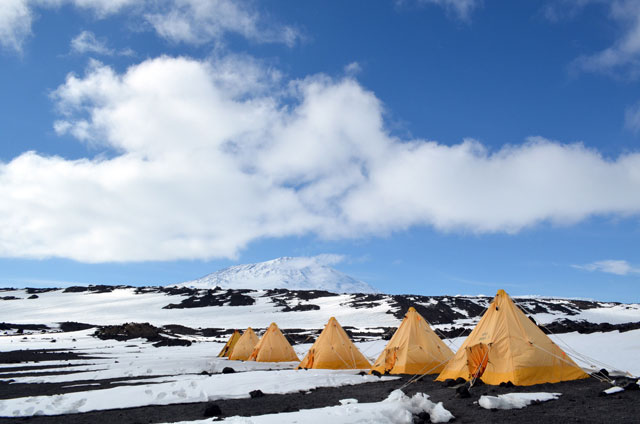Page 3/3 - Posted January 20, 2012
A home away from homeThere was only one professional carpenter among the Terra Nova crew, Francis Davies, who supervised the construction of the hut, which had been prefabricated in London. A test-build by the crew in Lyttelton, New Zealand, revealed serious deficiencies in the sizes and quantities of some timbers, which were corrected before the ship sailed to Antarctica. Scott was well pleased with his new Antarctic home, quite the contrast to his first effort in Antarctica on the Discovery Expedition of 1901-04 Scott’s own words describe the solace the building would bring against the harsh Antarctic climate: “The hut is progressing apace, and all agree that it should be the most perfectly comfortable habitation. It amply repays the time and attention given to the planning. The sides have double boarding inside and outside the frames, with a layer of our excellent quilted seaweed insulation between each pair of boardings.” Their new home was built in less than two weeks, much to Scott’s satisfaction: “The hut is becoming the most comfortable dwelling-place imaginable. We have made ourselves a truly seductive home, within the walls of which peace, quiet and comfort remain supreme. Such a noble dwelling transcends the word ‘hut’, and we pause to give it a more fitting title only from lack of the appropriate suggestion. What shall we call it? The word hut is misleading.” Ward agreed that it would have been a wonderful place to live. “It’s a very honest building. It’s not pretentious. It was here to do a purpose, and a hundred years later, it’s amazingly still structurally sound,” he says. “I love the weathering of the wood and the character in it.” Layers of historyRetaining that character has been a priority. But the question, at times, has been which character to retain, as the Terra Nova party wasn’t the last Heroic-era expedition to use the base. After the prize of the South Pole had been claimed by Amundsen on Dec. 14, 1911, Shackleton conceived of the Trans-Antarctic Expedition, which set off in 1914. The plan was for Shackleton to lead a team across the continent, beginning from the Weddell Sea, crossing the South Pole, and then north to the familiar territory of the Ross Sea. It never happened. The expedition’s ship, the Endurance, became locked in pack ice, and eventually crushed, stranding Shackleton and his men on the ice. What ensued would become known as one of the greatest stories of survival ever told, and Shackleton lionized as a fearless leader of men. A lesser-known story is that of Shackleton’s Ross Sea Party, charged with laying supplies across the Ross Ice Shelf for the Trans-Antarctic Expedition for the second leg of the adventure. They used and occupied the Cape Evans Hut for about two years, from 1915-17. “We try to keep both layers of history,” Meek says. “It was decided in the conservation plan that the aim was to restore this building as it was at the end of the Heroic Era, which is the end of the Ross Sea Party occupation, but with a focus on the Scott expedition.” That meant restoring the bulkhead of crates that had created a sort of wall in the middle of the hut, which separated the enlisted men on the Terra Nova expedition from the officers and scientists. Shackleton’s crew had no such prohibitions, so they tore it down. But the soot that coats the ceiling from the burning of seal blubber by half-starved members of the Ross Sea Party remains untouched. “It was quite amazing what a difference it made to the hut, to have that division in there again,” says Martin Wenzel, a restoration carpenter originally from Germany but who settled in New Zealand more than 20 years ago. “It gave you a completely different spatial feeling for the hut. It was really exciting to see. We hadn’t seen that before and experienced that before.” Wenzel had repaired many of the bulkhead crates, working by the “200-millimeter, two-meter rule,” meaning his fixes should be invisible at a distance of two meters or more, only noticeable to someone taking a closer look. This past year he completed off-site repairs to all of the food storage boxes at Cape Royds, which had been used by Shackleton’s men to build a garage and stable. The wood boxes had been full of food and falling part, with gull-like skuas scavenging the powdered flour, milk and eggs that had spilled out. “As we got inside the content, there were tins that were virtually new,” says Wenzel, who has worked for the Trust for four years, including a winter at Scott Base. “Some of them even had a recipe book in them.” Job satisfactionThe conservation team has no reservations about replacing more modern-day additions to the hut, particularly restoration work done in the 1970s. Fastier says the repairs done by those volunteers helped protect the structures, but they didn’t make any attempts to maintain historical accuracy. “It was well-intentioned conservation work at that time,” he says. The carpenters have had to swap out several windows, but have been fortunate to find some materials on site, including an old window frame in the stables. They had similar luck with the discovery of a door that they used to replace one from the 1970s. Fastier sees parallels between the ways his crew must be creative with their fixes and how the Scott and Shackleton parties might have once been forced to find their own innovative solutions to problems. “I think we’re the same in some ways. We’ve got the tools and good people, and we’ve got lots of challenges. If you think outside the square, you can make it happen,” he says. “In fact, quite often I think the old fellows are still behind us, helping us out, because we have a lot of luck with the weather and everything else. “At the end of the season, we’re typically all pretty tired, but we also leave pretty satisfied that we’ve done a good job,” he adds. “That’s our reward. Everyone is passionate and behind it.” Even the grandson of the famous explorer is behind it — and a part of it. Falcon Scott, only grandson of Robert Falcon Scott, joined the conservation effort in early January. [See related article — The next generation: Descendants of Scott and Amundsen find their way to Antarctica.] A self-taught builder by trade, Falcon Scott had applied for a job as a carpenter with the Trust several years ago. This year he finally got his chance. “I understand what the conservators are all about now,” he says after about a week or so on probably his most unusual job site. “It’s really quite a unique thing. You’re dealing with the history, but in another way, you’re moving into history. “This conservation project that they’re doing is going to be a major event in the life of the hut. In a hundred years time, they’ll say this was when major conservation was done,” he adds. “I’m pleased to be working with people who are doing such a professional job.”Back 1 2 3 |



For USAP Participants |
For The Public |
For Researchers and EducatorsContact UsU.S. National Science FoundationOffice of Polar Programs Geosciences Directorate 2415 Eisenhower Avenue, Suite W7100 Alexandria, VA 22314 Sign up for the NSF Office of Polar Programs newsletter and events. Feedback Form |

